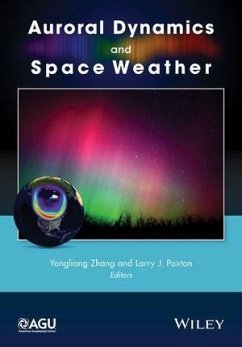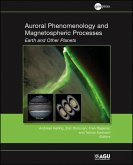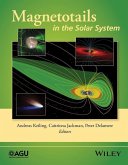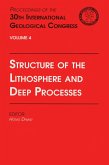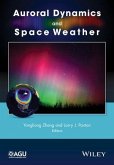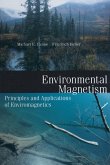Auroral Dynamics and Space Weather (eBook, PDF)
Redaktion: Zhang, Yongliang; Paxton, Larry J.


Alle Infos zum eBook verschenken

Auroral Dynamics and Space Weather (eBook, PDF)
Redaktion: Zhang, Yongliang; Paxton, Larry J.
- Format: PDF
- Merkliste
- Auf die Merkliste
- Bewerten Bewerten
- Teilen
- Produkt teilen
- Produkterinnerung
- Produkterinnerung

Hier können Sie sich einloggen

Bitte loggen Sie sich zunächst in Ihr Kundenkonto ein oder registrieren Sie sich bei bücher.de, um das eBook-Abo tolino select nutzen zu können.
The aurora is the most visible manifestation of the connection of the Earth to the space environment and has inspired awe, curiosity, and scientific inquiry for centuries. Recent advances in observing techniques and modeling and theoretical work have revealed new auroral phenomena, provided a better understanding of auroral dynamics, and have led to an enhanced capability for auroral forecasts. This monograph features discussions of: * New auroral phenomena due to the ring current ion and polar rain electron precipitation * Various auroral forms and hemispheric asymmetry * Auroral model…mehr
- Geräte: PC
- mit Kopierschutz
- eBook Hilfe
- Größe: 53MB
![Auroral Phenomenology and Magnetospheric Processes (eBook, PDF) Auroral Phenomenology and Magnetospheric Processes (eBook, PDF)]() Auroral Phenomenology and Magnetospheric Processes (eBook, PDF)127,99 €
Auroral Phenomenology and Magnetospheric Processes (eBook, PDF)127,99 €![Dynamics of the Earth's Radiation Belts and Inner Magnetosphere (eBook, PDF) Dynamics of the Earth's Radiation Belts and Inner Magnetosphere (eBook, PDF)]() Dynamics of the Earth's Radiation Belts and Inner Magnetosphere (eBook, PDF)122,99 €
Dynamics of the Earth's Radiation Belts and Inner Magnetosphere (eBook, PDF)122,99 €![Magnetotails in the Solar System (eBook, PDF) Magnetotails in the Solar System (eBook, PDF)]() Magnetotails in the Solar System (eBook, PDF)154,99 €
Magnetotails in the Solar System (eBook, PDF)154,99 €![Structure of the Lithosphere and Deep Processes (eBook, PDF) Structure of the Lithosphere and Deep Processes (eBook, PDF)]() Structure of the Lithosphere and Deep Processes (eBook, PDF)34,95 €
Structure of the Lithosphere and Deep Processes (eBook, PDF)34,95 €![Ionospheric Space Weather (eBook, PDF) Ionospheric Space Weather (eBook, PDF)]() Ionospheric Space Weather (eBook, PDF)167,99 €
Ionospheric Space Weather (eBook, PDF)167,99 €![Auroral Dynamics and Space Weather (eBook, ePUB) Auroral Dynamics and Space Weather (eBook, ePUB)]() Auroral Dynamics and Space Weather (eBook, ePUB)149,99 €
Auroral Dynamics and Space Weather (eBook, ePUB)149,99 €![Environmental Magnetism (eBook, PDF) Environmental Magnetism (eBook, PDF)]() Mark EvansEnvironmental Magnetism (eBook, PDF)63,95 €
Mark EvansEnvironmental Magnetism (eBook, PDF)63,95 €-
-
-
Dieser Download kann aus rechtlichen Gründen nur mit Rechnungsadresse in A, B, BG, CY, CZ, D, DK, EW, E, FIN, F, GR, HR, H, IRL, I, LT, L, LR, M, NL, PL, P, R, S, SLO, SK ausgeliefert werden.
- Produktdetails
- Verlag: John Wiley & Sons
- Seitenzahl: 324
- Erscheinungstermin: 10. November 2015
- Englisch
- ISBN-13: 9781118978733
- Artikelnr.: 44185906
- Verlag: John Wiley & Sons
- Seitenzahl: 324
- Erscheinungstermin: 10. November 2015
- Englisch
- ISBN-13: 9781118978733
- Artikelnr.: 44185906
Contributors
Preface
Acknowledgement
Section I: Aurora Types and Dynamics
Investigations of the Many Distinct Types of Aurorae
Christopher Colpitts
Quasiperiodic aurora: Outstanding problems and recent results
Eric Lund
Inverted-V Auroral Arcs and Alfvén Waves
Christopher Chaston
Auroral Arcs and Ion Outflow
Romain Maggiolo
Isolated proton aurora and Pc1/EMIC waves at subauroral latitudes
Kaori Sakaguchi, Kazuo Shiokawa, Yoshizumi Miyoshim, and Marin Connors
Dynamics of the Dayside Aurora as Viewed from the South Pole
D. J. McEwen, G. G. Sivjee, and Y. Zhang
Structures in Polar Rain Aurora
Yongliang Zhang, Larry Paxton, and Hyosub Kil
Dynamics Related to Plasma Sheet Flow Bursts as Revealed from the Aurora
Larry R. Lyons, Toshi Nishimura, Bea Gallardo-Lacourt, Ying Zou, Eric Donovan, Stephen Mende, Vassilis Angelopoulos, John M. Ruohoniemi, Kathryn A. McWilliams, Don L. Hampton, and Michael J. Nicolls
The Role of Multiple Atmospheric Reflections in the Formation of the Electron Distribution Function in the Diffuse Aurora Region
George Khazanov, Elizabeth Himwich, Alex Glocer, and David Sibeck
¯ Section II: Hemispheric Conjugacy of Aurora
What are the mechanisms that produce auroral asymmetries in the conjugate hemispheres?
Nikolai Østgaard, Jone Reistad, Paul Tenfjord, Larl Laundal, Kristian Snekvik, Steve Milan, Stein Haaland
Interhemispheric symmetries and asymmetries of the aurora from ground-based conjugate observations
Natsuo Sato
Section III: Substorm Aurora
Magnetospheric Substorm Onset by Current Disruption Processes
Anthony Lui
Substorm auroral dynamics reproduced by the advanced M-I coupling simulation,
Tanaka, Takashi
Section IV: Radio Aurora
The Radar Aurora
David Hysell
GPS phase scintillation at high latitudes during two geomagnetic storms
Paul Prikryl, Reza Ghoddousi-Fard, John M. Rouhoniemi, and Evan G. Thomas
Radio absorption in auroral region
John K. Hargreaves
Auroral Kilometric Radiation: Polarization and Spectra Observed far from the Earth,
Kozo Hashimoto, Yoshitaka Goto, Yoshiya Kasahara, Hiroshi Matsumoto, and Roger R. Anderson
Section V: Auroral Models and Predictions
Auroral Precipitation Models and Space Weather
Patrick Newell, K. Liou, Y. Zhang, T. Sotirelis, L.J. Paxton, and E.J. Mitchell
Space Weather Products and Tools used in Auroral Monitoring and Forecasting at CCMC/SWRC
Yihua Zheng, and Lutz Rastaetter
Contributors
Preface
Acknowledgement
Section I: Aurora Types and Dynamics
Investigations of the Many Distinct Types of Aurorae
Christopher Colpitts
Quasiperiodic aurora: Outstanding problems and recent results
Eric Lund
Inverted-V Auroral Arcs and Alfvén Waves
Christopher Chaston
Auroral Arcs and Ion Outflow
Romain Maggiolo
Isolated proton aurora and Pc1/EMIC waves at subauroral latitudes
Kaori Sakaguchi, Kazuo Shiokawa, Yoshizumi Miyoshim, and Marin Connors
Dynamics of the Dayside Aurora as Viewed from the South Pole
D. J. McEwen, G. G. Sivjee, and Y. Zhang
Structures in Polar Rain Aurora
Yongliang Zhang, Larry Paxton, and Hyosub Kil
Dynamics Related to Plasma Sheet Flow Bursts as Revealed from the Aurora
Larry R. Lyons, Toshi Nishimura, Bea Gallardo-Lacourt, Ying Zou, Eric Donovan, Stephen Mende, Vassilis Angelopoulos, John M. Ruohoniemi, Kathryn A. McWilliams, Don L. Hampton, and Michael J. Nicolls
The Role of Multiple Atmospheric Reflections in the Formation of the Electron Distribution Function in the Diffuse Aurora Region
George Khazanov, Elizabeth Himwich, Alex Glocer, and David Sibeck
¯ Section II: Hemispheric Conjugacy of Aurora
What are the mechanisms that produce auroral asymmetries in the conjugate hemispheres?
Nikolai Østgaard, Jone Reistad, Paul Tenfjord, Larl Laundal, Kristian Snekvik, Steve Milan, Stein Haaland
Interhemispheric symmetries and asymmetries of the aurora from ground-based conjugate observations
Natsuo Sato
Section III: Substorm Aurora
Magnetospheric Substorm Onset by Current Disruption Processes
Anthony Lui
Substorm auroral dynamics reproduced by the advanced M-I coupling simulation,
Tanaka, Takashi
Section IV: Radio Aurora
The Radar Aurora
David Hysell
GPS phase scintillation at high latitudes during two geomagnetic storms
Paul Prikryl, Reza Ghoddousi-Fard, John M. Rouhoniemi, and Evan G. Thomas
Radio absorption in auroral region
John K. Hargreaves
Auroral Kilometric Radiation: Polarization and Spectra Observed far from the Earth,
Kozo Hashimoto, Yoshitaka Goto, Yoshiya Kasahara, Hiroshi Matsumoto, and Roger R. Anderson
Section V: Auroral Models and Predictions
Auroral Precipitation Models and Space Weather
Patrick Newell, K. Liou, Y. Zhang, T. Sotirelis, L.J. Paxton, and E.J. Mitchell
Space Weather Products and Tools used in Auroral Monitoring and Forecasting at CCMC/SWRC
Yihua Zheng, and Lutz Rastaetter
